2014 NISSAN PATHFINDER CD player
[x] Cancel search: CD playerPage 367 of 492
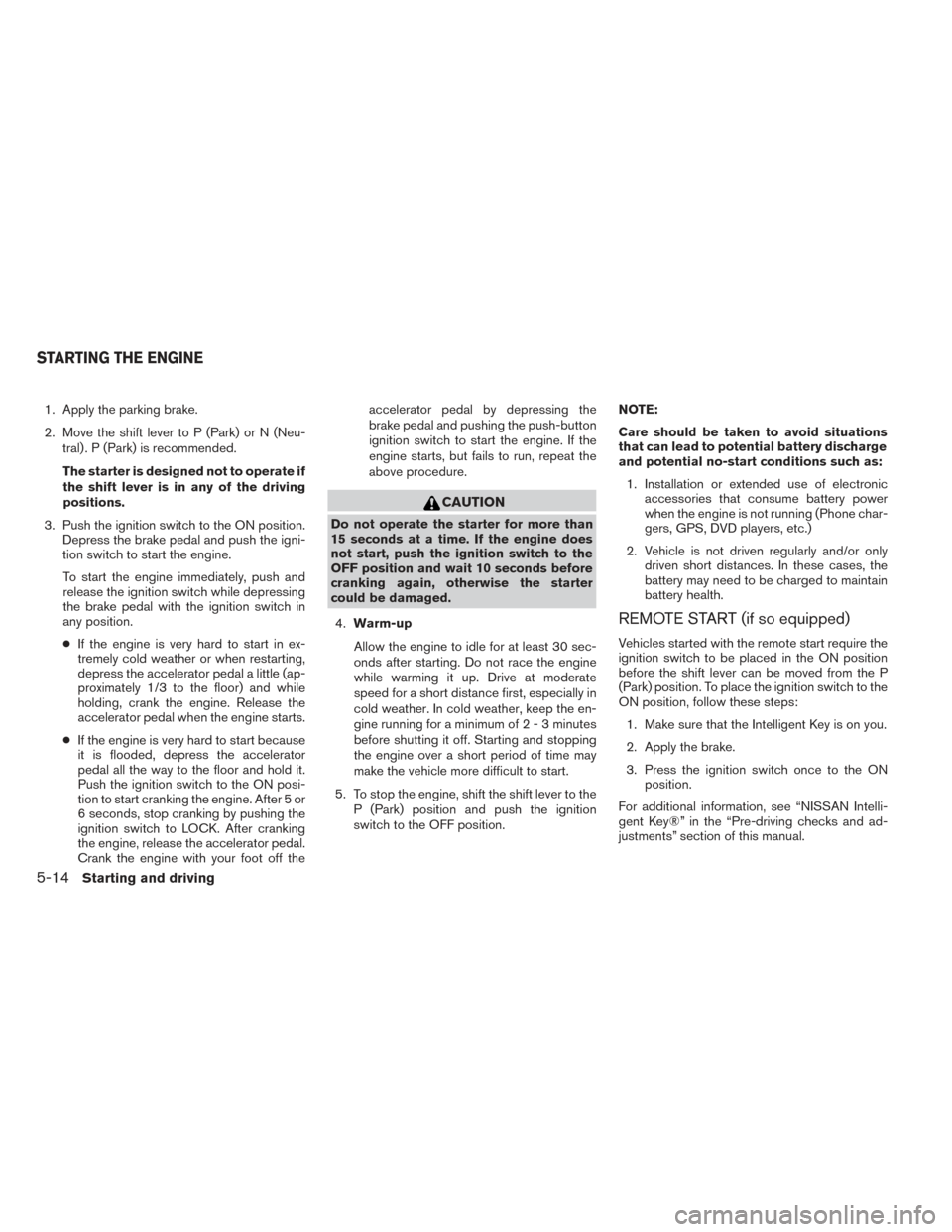
1. Apply the parking brake.
2. Move the shift lever to P (Park) or N (Neu-tral) . P (Park) is recommended.
The starter is designed not to operate if
the shift lever is in any of the driving
positions.
3. Push the ignition switch to the ON position. Depress the brake pedal and push the igni-
tion switch to start the engine.
To start the engine immediately, push and
release the ignition switch while depressing
the brake pedal with the ignition switch in
any position.
● If the engine is very hard to start in ex-
tremely cold weather or when restarting,
depress the accelerator pedal a little (ap-
proximately 1/3 to the floor) and while
holding, crank the engine. Release the
accelerator pedal when the engine starts.
● If the engine is very hard to start because
it is flooded, depress the accelerator
pedal all the way to the floor and hold it.
Push the ignition switch to the ON posi-
tion to start cranking the engine. After 5 or
6 seconds, stop cranking by pushing the
ignition switch to LOCK. After cranking
the engine, release the accelerator pedal.
Crank the engine with your foot off the accelerator pedal by depressing the
brake pedal and pushing the push-button
ignition switch to start the engine. If the
engine starts, but fails to run, repeat the
above procedure.
CAUTION
Do not operate the starter for more than
15 seconds at a time. If the engine does
not start, push the ignition switch to the
OFF position and wait 10 seconds before
cranking again, otherwise the starter
could be damaged.
4. Warm-up
Allow the engine to idle for at least 30 sec-
onds after starting. Do not race the engine
while warming it up. Drive at moderate
speed for a short distance first, especially in
cold weather. In cold weather, keep the en-
gine running for a minimum of2-3minutes
before shutting it off. Starting and stopping
the engine over a short period of time may
make the vehicle more difficult to start.
5. To stop the engine, shift the shift lever to the P (Park) position and push the ignition
switch to the OFF position. NOTE:
Care should be taken to avoid situations
that can lead to potential battery discharge
and potential no-start conditions such as:
1. Installation or extended use of electronic accessories that consume battery power
when the engine is not running (Phone char-
gers, GPS, DVD players, etc.)
2. Vehicle is not driven regularly and/or only driven short distances. In these cases, the
battery may need to be charged to maintain
battery health.
REMOTE START (if so equipped)
Vehicles started with the remote start require the
ignition switch to be placed in the ON position
before the shift lever can be moved from the P
(Park) position. To place the ignition switch to the
ON position, follow these steps:
1. Make sure that the Intelligent Key is on you.
2. Apply the brake.
3. Press the ignition switch once to the ON position.
For additional information, see “NISSAN Intelli-
gent Key®” in the “Pre-driving checks and ad-
justments” section of this manual.
STARTING THE ENGINE
5-14Starting and driving
Page 415 of 492
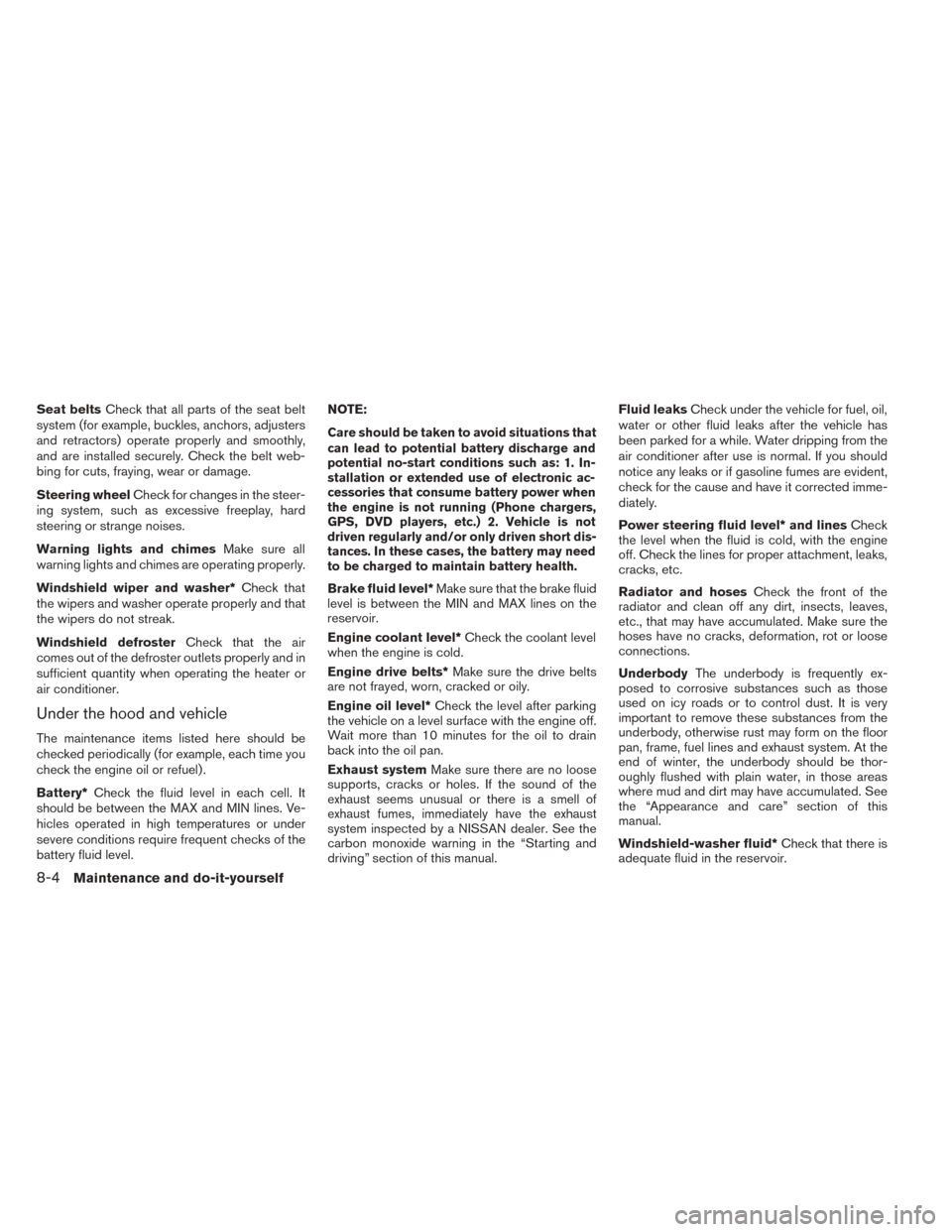
Seat beltsCheck that all parts of the seat belt
system (for example, buckles, anchors, adjusters
and retractors) operate properly and smoothly,
and are installed securely. Check the belt web-
bing for cuts, fraying, wear or damage.
Steering wheel Check for changes in the steer-
ing system, such as excessive freeplay, hard
steering or strange noises.
Warning lights and chimes Make sure all
warning lights and chimes are operating properly.
Windshield wiper and washer* Check that
the wipers and washer operate properly and that
the wipers do not streak.
Windshield defroster Check that the air
comes out of the defroster outlets properly and in
sufficient quantity when operating the heater or
air conditioner.
Under the hood and vehicle
The maintenance items listed here should be
checked periodically (for example, each time you
check the engine oil or refuel) .
Battery* Check the fluid level in each cell. It
should be between the MAX and MIN lines. Ve-
hicles operated in high temperatures or under
severe conditions require frequent checks of the
battery fluid level. NOTE:
Care should be taken to avoid situations that
can lead to potential battery discharge and
potential no-start conditions such as: 1. In-
stallation or extended use of electronic ac-
cessories that consume battery power when
the engine is not running (Phone chargers,
GPS, DVD players, etc.) 2. Vehicle is not
driven regularly and/or only driven short dis-
tances. In these cases, the battery may need
to be charged to maintain battery health.
Brake fluid level*
Make sure that the brake fluid
level is between the MIN and MAX lines on the
reservoir.
Engine coolant level* Check the coolant level
when the engine is cold.
Engine drive belts* Make sure the drive belts
are not frayed, worn, cracked or oily.
Engine oil level* Check the level after parking
the vehicle on a level surface with the engine off.
Wait more than 10 minutes for the oil to drain
back into the oil pan.
Exhaust system Make sure there are no loose
supports, cracks or holes. If the sound of the
exhaust seems unusual or there is a smell of
exhaust fumes, immediately have the exhaust
system inspected by a NISSAN dealer. See the
carbon monoxide warning in the “Starting and
driving” section of this manual. Fluid leaks
Check under the vehicle for fuel, oil,
water or other fluid leaks after the vehicle has
been parked for a while. Water dripping from the
air conditioner after use is normal. If you should
notice any leaks or if gasoline fumes are evident,
check for the cause and have it corrected imme-
diately.
Power steering fluid level* and lines Check
the level when the fluid is cold, with the engine
off. Check the lines for proper attachment, leaks,
cracks, etc.
Radiator and hoses Check the front of the
radiator and clean off any dirt, insects, leaves,
etc., that may have accumulated. Make sure the
hoses have no cracks, deformation, rot or loose
connections.
Underbody The underbody is frequently ex-
posed to corrosive substances such as those
used on icy roads or to control dust. It is very
important to remove these substances from the
underbody, otherwise rust may form on the floor
pan, frame, fuel lines and exhaust system. At the
end of winter, the underbody should be thor-
oughly flushed with plain water, in those areas
where mud and dirt may have accumulated. See
the “Appearance and care” section of this
manual.
Windshield-washer fluid* Check that there is
adequate fluid in the reservoir.
8-4Maintenance and do-it-yourself
Page 425 of 492
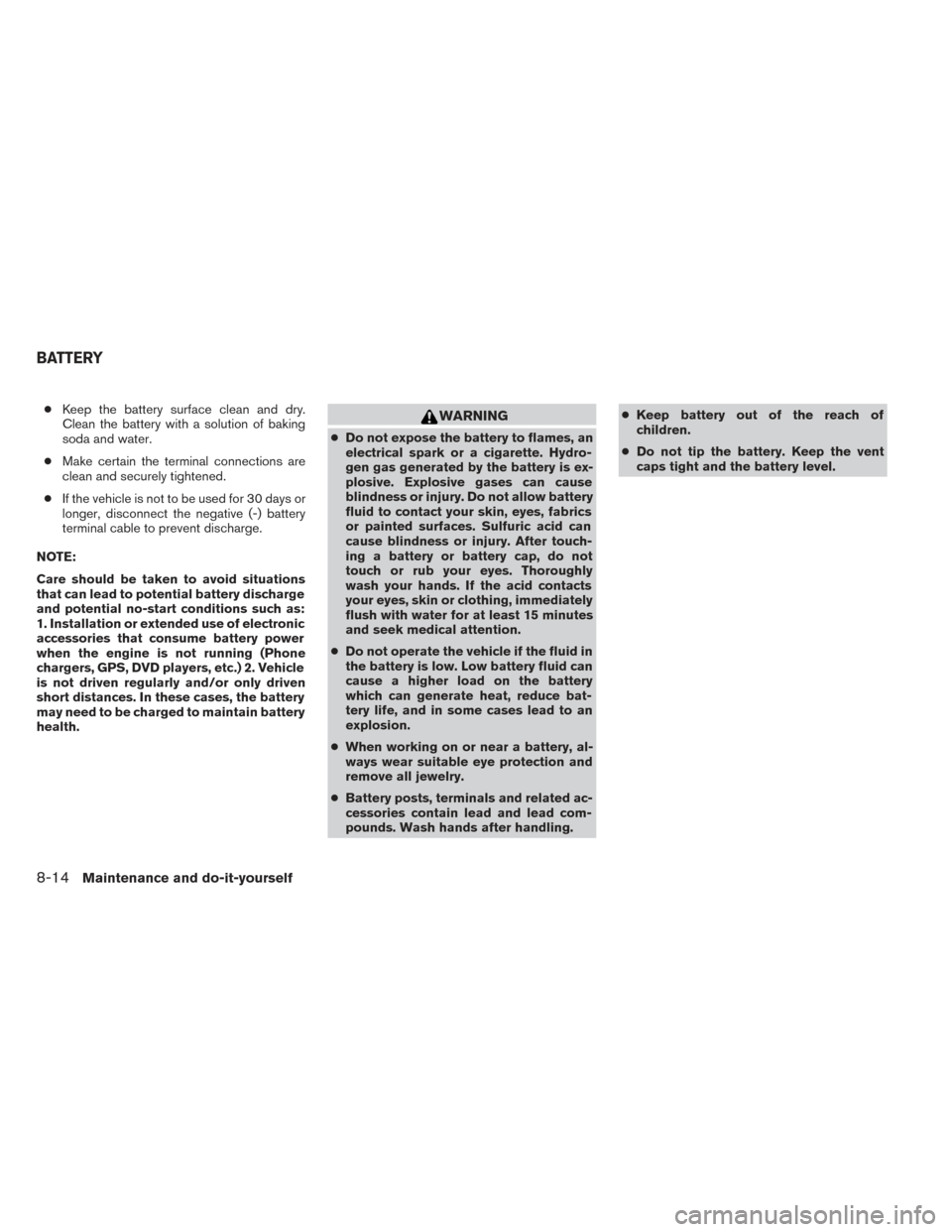
●Keep the battery surface clean and dry.
Clean the battery with a solution of baking
soda and water.
● Make certain the terminal connections are
clean and securely tightened.
● If the vehicle is not to be used for 30 days or
longer, disconnect the negative (-) battery
terminal cable to prevent discharge.
NOTE:
Care should be taken to avoid situations
that can lead to potential battery discharge
and potential no-start conditions such as:
1. Installation or extended use of electronic
accessories that consume battery power
when the engine is not running (Phone
chargers, GPS, DVD players, etc.) 2. Vehicle
is not driven regularly and/or only driven
short distances. In these cases, the battery
may need to be charged to maintain battery
health.WARNING
● Do not expose the battery to flames, an
electrical spark or a cigarette. Hydro-
gen gas generated by the battery is ex-
plosive. Explosive gases can cause
blindness or injury. Do not allow battery
fluid to contact your skin, eyes, fabrics
or painted surfaces. Sulfuric acid can
cause blindness or injury. After touch-
ing a battery or battery cap, do not
touch or rub your eyes. Thoroughly
wash your hands. If the acid contacts
your eyes, skin or clothing, immediately
flush with water for at least 15 minutes
and seek medical attention.
● Do not operate the vehicle if the fluid in
the battery is low. Low battery fluid can
cause a higher load on the battery
which can generate heat, reduce bat-
tery life, and in some cases lead to an
explosion.
● When working on or near a battery, al-
ways wear suitable eye protection and
remove all jewelry.
● Battery posts, terminals and related ac-
cessories contain lead and lead com-
pounds. Wash hands after handling. ●
Keep battery out of the reach of
children.
● Do not tip the battery. Keep the vent
caps tight and the battery level.
BATTERY
8-14Maintenance and do-it-yourself
Page 484 of 492

10 Index
A
Air bag (See supplemental restraint
system) .....................1-53
Air bag system Front (See supplemental front impact
air bag system) ...............1-60
Airbagwarninglabels.............1-68
Airbagwarninglight...........1-68,2-14
Air cleaner housing filter ............8-18
Air conditioner Air conditioner service ...........4-49
Air conditioner specification label .....9-11
Air conditioner system refrigerant and
oil recommendations .............9-6
Heater and air conditioner
controls................4-41,4-45
Rear seat air conditioner ..........4-43
Servicing air conditioner ..........4-49
Alarm system
(See vehicle security system) .........2-26
Anchor point locations .............1-38
Antenna....................4-104
Anti-lock brake warning light ..........2-10
Anti-lock Braking System (ABS) ........5-28
Audible reminders ...............2-16
Audio system ..................4-49
Bluetooth®audio..............4-99
Compact Disc (CD) changer .......4-67
Compact disc (CD) player .....4-74,4-81
FM-AM radio with compact disc
(CD) changer ................4-65 FM/AM/SAT radio with CD/DVD player . .4-77
FM/AM/SAT radio with compact disc
(CD) player
.................4-70
Audio System iPod®Player.............4-93,4-95
Audio system Radio ....................4-49
Steering wheel audio control switch . . .4-103
USB interface ............4-88,4-90
Autolight switch .................2-32
Automatic Automatic drive positioner .........3-35
Automatic power window switch .....2-52
Automatic anti-glare inside mirror .......3-32
Automatic door locks ..............3-6
AUXjack ....................4-69
B
Battery ......................8-14
Charge warning light ............2-11
Before starting the engine ...........5-13
Belt (See drive belt) ..............8-16
Block heater Engine ....................5-34
Bluetooth®audio................4-99
Bluetooth® hands-free phone
system .................4- 118, 4-131
Boosterseats..................1-50
Brake Anti-lock Braking System (ABS) ......5-28
Brake fluid ..................8-12 Brakelight(Seestoplight).........8-26
Brake system
................5-27
Brake warning light .............2-11
Brake wear indicators ........2-16,8-20
Parking brake operation ..........5-18
Self-adjusting brakes ............8-20
Brakes ......................8-20
Break-inschedule ...............5-21
Brightness/contrast button .......4-11,4-20
Brightness control Instrument panel ..............2-34
Bulb check/instrument panel ..........2-10
Bulbreplacement................8-26
C
Capacities and recommended
fuel/lubricants ...................9-2
Cargolight ...................2-57
Cargo
(See vehicle loading information) . . .9-12
Car phone or CB radio ............4-117
CD care and cleaning .............4-102
CD changer (See audio system) .......4-67
CD player (See audio system) .....4-74,4-81
Check tire pressure ...............2-25
Child restraints .......1-31,1-32,1-33,1-35
Precautions on child
restraints ........1-33,1-40,1-45,1-50
Top tether strap anchor point locations . .1-38
Child restraint with top tether strap ......1-37
Child safety rear door lock ............3-7
Chimes,audiblereminders...........2-16
Page 485 of 492
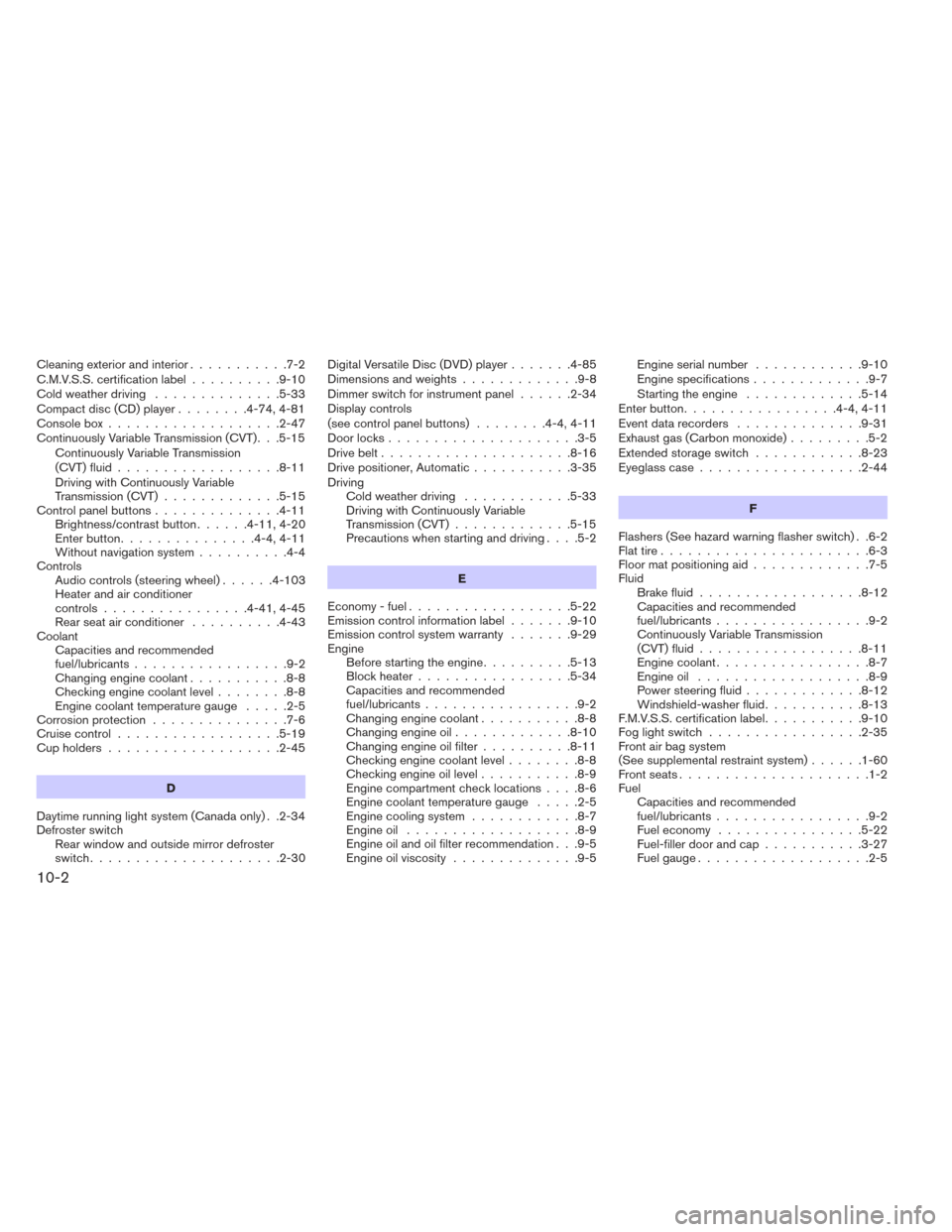
Cleaning exterior and interior...........7-2
C.M.V.S.S. certification label ..........9-10
Cold weather driving ..............5-33
Compact disc (CD) player ........4-74,4-81
Consolebox...................2-47
Continuously Variable Transmission (CVT). . .5-15 Continuously Variable Transmission
(CVT) fluid ..................8-11
Driving with Continuously Variable
Transmission (CVT) .............5-15
Control panel buttons ..............4-11
Brightness/contrast button ......4-11,4-20
Enterbutton...............4-4,4-11
Without navigation system ..........4-4
Controls Audiocontrols(steeringwheel)......4-103
Heater and air conditioner
controls ................4-41,4-45
Rear seat air conditioner ..........4-43
Coolant Capacities and recommended
fuel/lubricants .................9-2
Changing engine coolant ...........8-8
Checking engine coolant level ........8-8
Engine coolant temperature gauge .....2-5
Corrosionprotection ...............7-6
Cruisecontrol..................5-19
Cupholders...................2-45
D
Daytime running light system (Canada only) . .2-34
Defroster switch Rear window and outside mirror defroster
switch.....................2-30 Digital Versatile Disc (DVD) player
.......4-85
Dimensionsandweights.............9-8
Dimmer switch for instrument panel ......2-34
Display controls
(seecontrolpanelbuttons) ........4-4,4-11
Door locks .....................3-5
Drive belt .....................8-16
Drive positioner, Automatic ...........3-35
Driving Cold weather driving ............5-33
Driving with Continuously Variable
Transmission (CVT) .............5-15
Precautions when starting and driving ....5-2
E
Economy - fuel ..................5-22
Emission control information label .......9-10
Emission control system warranty .......9-29
Engine Before starting the engine ..........5-13
Block heater .................5-34
Capacities and recommended
fuel/lubricants .................9-2
Changingenginecoolant...........8-8
Changingengineoil.............8-10
Changing engine oil filter ..........8-11
Checking engine coolant level ........8-8
Checking engine oil level ...........8-9
Engine compartment check locations ....8-6
Engine coolant temperature gauge .....2-5
Engine cooling system ............8-7
Engineoil ...................8-9
Engine oil and oil filter recommendation . . .9-5
Engine oil viscosity ..............9-5 Engine serial number
............9-10
Engine specifications .............9-7
Starting the engine .............5-14
Enterbutton.................4-4,4-11
Eventdatarecorders ..............9-31
Exhaustgas(Carbonmonoxide).........5-2
Extended storage switch ............8-23
Eyeglass case ..................2-44
F
Flashers (See hazard warning flasher switch) . .6-2
Flat tire .......................6-3
Floor mat positioning aid .............7-5
Fluid Brake fluid ..................
8-12
Capacities and recommended
fuel/lubricants .................9-2
Continuously Variable Transmission
(CVT) fluid ..................8-11
Engine coolant .................8-7
Engine oil ...................8-9
Power steering fluid .............8-12
Windshield-washer fluid ...........8-13
F.M.V.S.S. certification label ...........9-10
Foglightswitch .................2-35
Front air bag system
(See supplemental restraint system) ......1-60
Front seats .....................1-2
Fuel Capacities and recommended
fuel/lubricants .................9-2
Fuel economy ................5-22
Fuel-filler door and cap ...........3-27
Fuelgauge...................2-5
10-2
Page 486 of 492
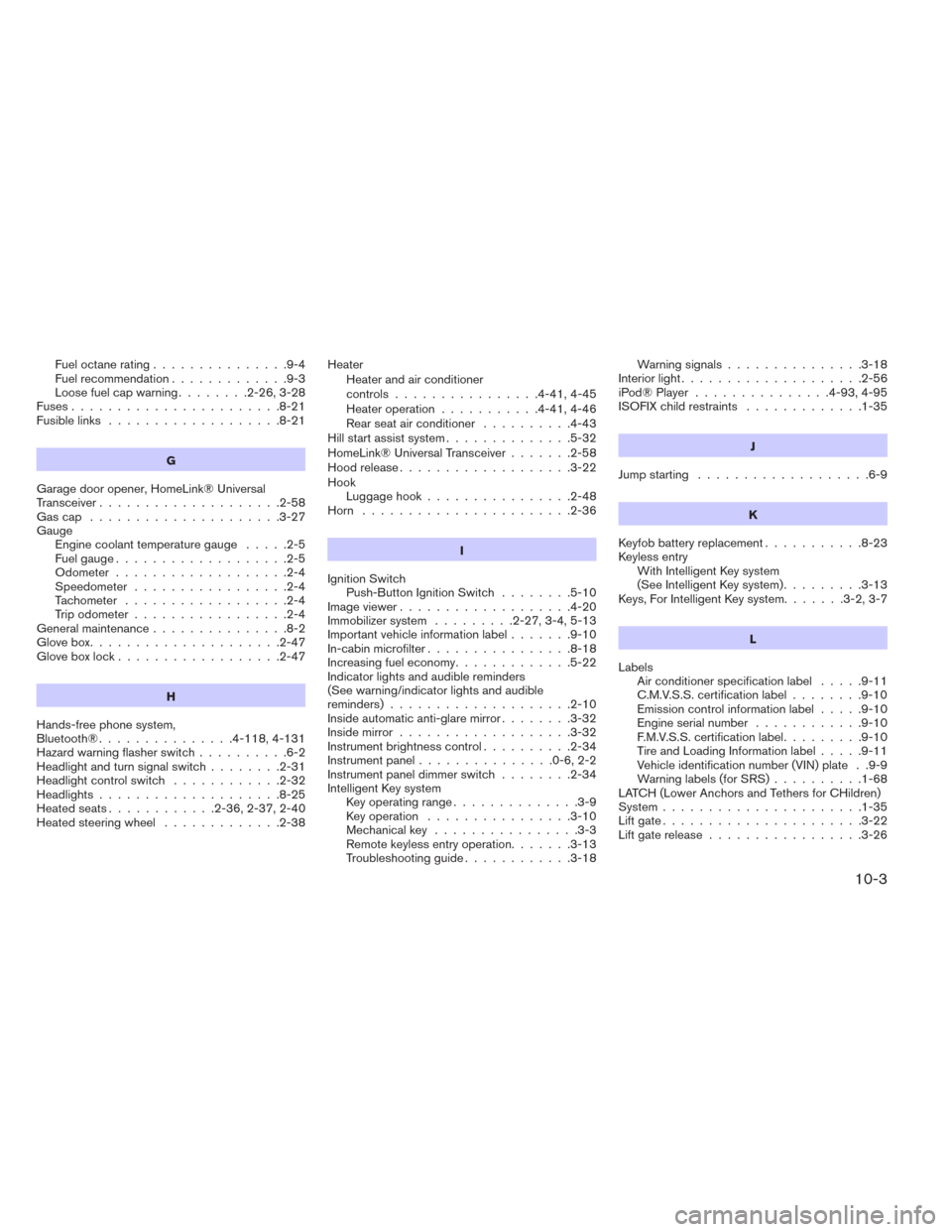
Fueloctanerating...............9-4
Fuel recommendation.............9-3
Loosefuelcapwarning........2-26,3-28
Fuses.......................8-21
Fusiblelinks ...................8-21
G
Garage door opener, HomeLink® Universal
Transceiver....................2-58
Gascap .....................3-27
Gauge Engine coolant temperature gauge .....2-5
Fuel gauge ...................2-5
Odometer ...................2-4
Speedometer .................2-4
Tachometer ..................2-4
Trip odometer .................2-4
Generalmaintenance...............8-2
Glovebox.....................2-47
Gloveboxlock..................2-47
H
Hands-free phone system,
Bluetooth®...............4- 118, 4-131
Hazard warning flasher switch ..........6-2
Headlightandturnsignalswitch........2-31
Headlightcontrolswitch ............2-32
Headlights....................8-25
Heated seats ............2-36,2-37,2-40
Heated steering wheel .............2-38 Heater
Heater and air conditioner
controls................4-41,4-45
Heater operation ...........4-41,4-46
Rear seat air conditioner ..........4-43
Hill start assist system ..............5-32
HomeLink® Universal Transceiver .......2-58
Hood release ...................3-22
Hook Luggagehook................2-48
Horn .......................2-36
I
Ignition Switch Push-Button Ignition Switch ........5-10
Image viewer ...................4-20
Immobilizer system .........2-27,3-4,5-13
Important vehicle information label .......9-10
In-cabin microfilter ................8-18
Increasing fuel economy .............5-22
Indicator lights and audible reminders
(See warning/indicator lights and audible
reminders)....................2-10
Inside automatic anti-glare mirror ........3-32
Inside mirror ...................3-32
Instrument brightness control ..........2-34
Instrument panel ...............0-6,2-2
Instrument panel dimmer switch ........2-34
Intelligent Key system Key operating range ..............3-9
Key operation ................3-10
Mechanicalkey ................3-3
Remote keyless entry operation .......3-13
Troubleshooting guide ............3-18 Warning signals
...............3-18
Interiorlight....................2-56
iPod® Player ...............4-93,4-95
ISOFIX child restraints .............1-35
J
Jump starting ...................6-9
K
Keyfob battery replacement ...........8-23
Keyless entry With Intelligent Key system
(See Intelligent Key system) .........3-13
Keys, For Intelligent Key system .......3-2,3-7
L
Labels Air conditioner specification label .....9-11
C.M.V.S.S. certification label ........9-10
Emission control information label .....
9-10
Engine serial number ............9-10
F.M.V.S.S. certification label .........9-10
Tire and Loading Information label .....9-11
Vehicle identification number (VIN) plate . .9-9
Warning labels (for SRS) ..........1-68
LATCH (Lower Anchors and Tethers for CHildren)
System ......................1-35
Liftgate......................3-22
Lift gate release .................3-26
10-3
Page 488 of 492
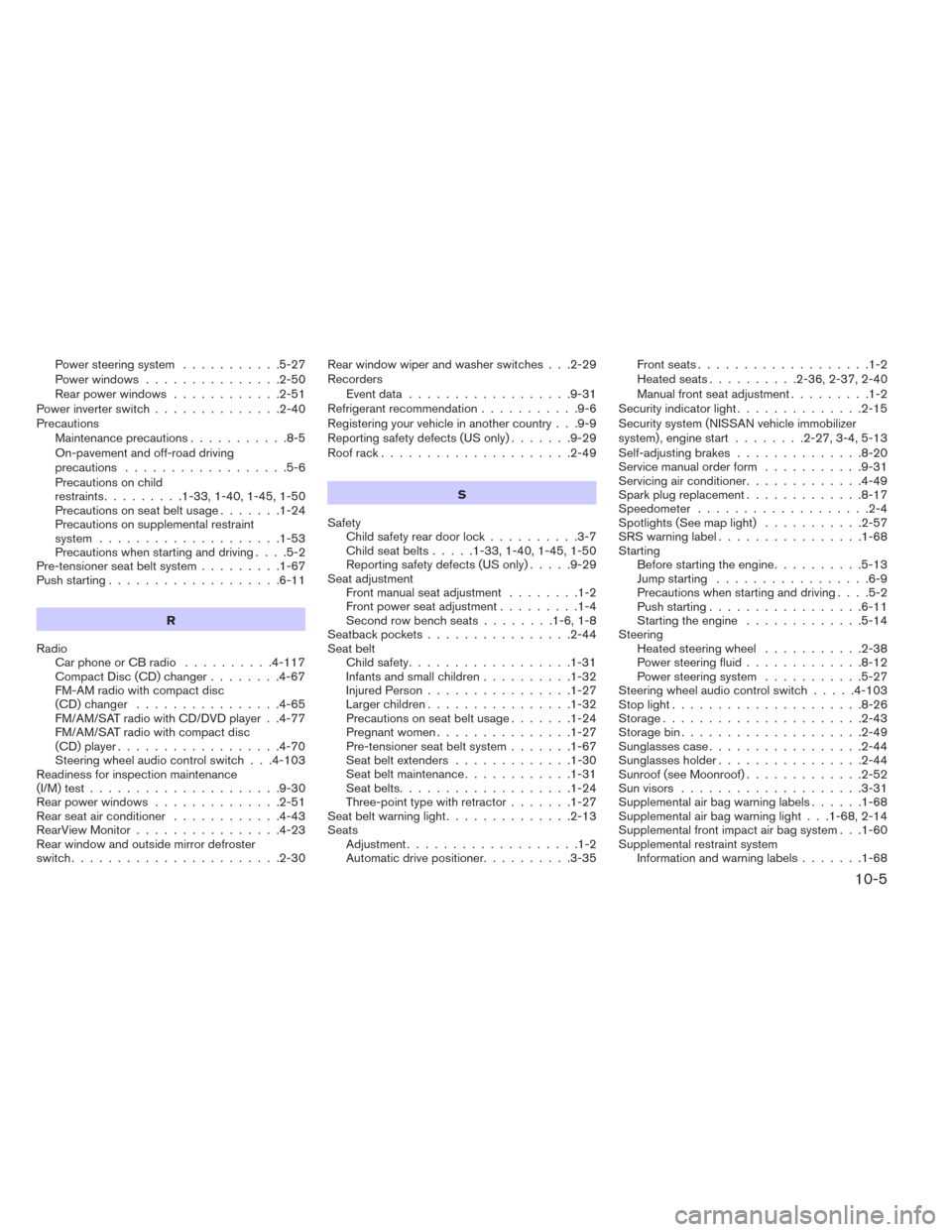
Power steering system...........5-27
Power windows ...............2-50
Rear power windows ............2-51
Powerinverterswitch..............2-40
Precautions Maintenanceprecautions...........8-5
On-pavement and off-road driving
precautions ..................5-6
Precautions on child
restraints .........1-33,1-40,1-45,1-50
Precautionsonseatbeltusage.......1-24
Precautions on supplemental restraint
system ....................1-53
Precautions when starting and driving ....5-2
Pre-tensioner seat belt system .........1-67
Push starting ...................6-11
R
Radio Car phone or CB radio ..........4-117
Compact Disc (CD) changer ........4-67
FM-AM radio with compact disc
(CD) changer ................4-65
FM/AM/SAT radio with CD/DVD player . .4-77
FM/AM/SAT radio with compact disc
(CD) player ..................4-70
Steering wheel audio control switch . . .4-103
Readiness for inspection maintenance
(I/M) test .....................9-30
Rear power windows ..............2-51
Rear seat air conditioner ............4-43
RearViewMonitor................4-23
Rear window and outside mirror defroster
switch .......................2-30 Rear window wiper and washer switches . . .2-29
Recorders
Eventdata..................9-31
Refrigerant recommendation ...........9-6
Registering your vehicle in another country . . .9-9
Reporting safety defects (US only) .......9-29
Roof rack .....................2-49
S
Safety Child safety rear door lock ..........3-7
Childseatbelts.....1-33,1-40,1-45,1-50
Reporting safety defects (US only) .....9-29
Seat adjustment Frontmanualseatadjustment ........1-2
Front power seat adjustment .........1-4
Second row bench seats ........1-6,1-8
Seatback pockets ................2-44
Seat belt Child safety ..................1-31
Infants and small children ..........1-32
Injured Person ................1-27
Largerchildren................1-32
Precautions on seat belt usage .......1-24
Pregnant women ...............1-27
Pre-tensioner seat belt system .......1-67
Seatbeltextenders .............1-30
Seatbeltmaintenance............1-31
Seatbelts...................1-24
Three-point type with retractor .......1-27
Seat belt warning light ..............2-13
Seats Adjustment ...................1-2
Automatic drive positioner ..........3-35 Frontseats...................1-2
Heated seats
..........2-36,2-37,2-40
Manual front seat adjustment .........1-2
Security indicator light ..............2-15
Security system (NISSAN vehicle immobilizer
system) , engine start ........2-27,3-4,5-13
Self-adjusting brakes ..............8-20
Service manual order form ...........9-31
Servicing air conditioner .............4-49
Spark plug replacement .............8-17
Speedometer ...................2-4
Spotlights(Seemaplight) ...........2-57
SRSwarninglabel................1-68
Starting Before
starting the engine ..........5-13
Jump starting .................6-9
Precautions when starting and driving ....5-2
Push starting .................6-11
Starting the engine .............5-14
Steering Heated steering wheel ...........2-38
Power steering fluid .............8-12
Power steering system ...........5-27
Steering wheel audio control switch .....4-103
Stoplight.....................8-26
Storage......................2-43
Storagebin....................2-49
Sunglasses case .................2-44
Sunglasses holder ................2-44
Sunroof (see Moonroof) .............2-52
Sun visors ....................3-31
Supplemental air bag warning labels ......1-68
Supplemental air bag warning light . . .1-68, 2-14
Supplemental front impact air bag system . . .1-60
Supplemental restraint system Information and warning labels .......1-68
10-5